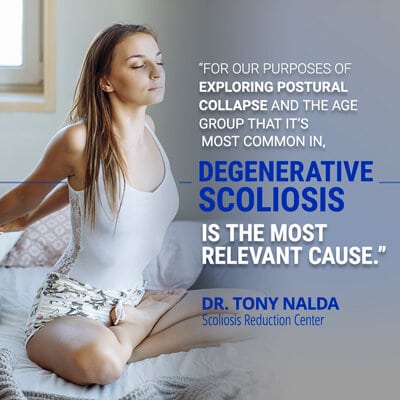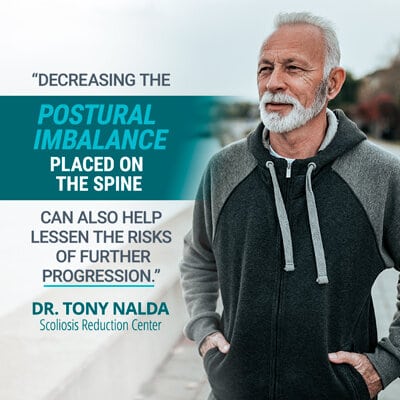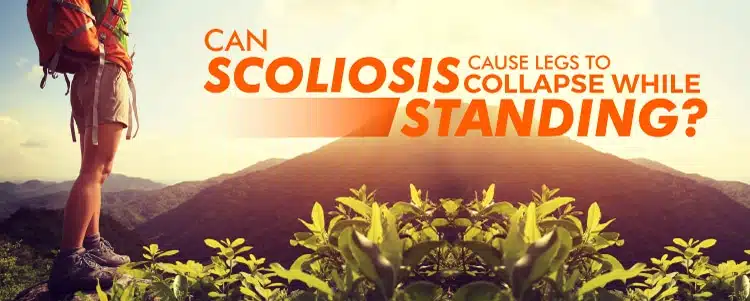When it comes to the postural collapse that would cause legs to give way while standing, this is not a common problem in the majority of scoliosis cases; however, with elderly people living with degenerative scoliosis, this can occur as a complication.
The Primary Age Group of People with Scoliosis
To fully answer the question of how likely postural collapse can be with scoliosis, the age group that most commonly faces the condition should be addressed.
The majority of scoliosis cases are adolescent, with the largest group of people receiving a scoliosis diagnosis between the ages of 10 and 18. For this group, postural collapse is highly unlikely. In fact, most of my patients with adolescent idiopathic scoliosis don’t experience noticeable symptoms until the condition has progressed in severity.
The absence of noticeable symptoms is the reason so many scoliosis cases either go undiagnosed or aren’t diagnosed until the condition has been progressing unimpeded for quite some time.
This is part of the reason I wrote my book Scoliosis Hope, to educate people and caregivers on the early signs of scoliosis. With any progressive condition, early diagnosis is key. The earlier a condition is caught, the sooner treatment can be started. Patients who come to me early on in their condition, or that I diagnose while the condition is in the mild stage, experience greater levels of successful treatment.
While legs collapsing is not a common symptom of scoliosis, that can be said because the majority of individuals diagnosed with the condition are adolescents. For adolescents, the scoliosis spine is very different than adult patients facing the degenerative effects of aging.
Symptoms of Adult Scoliosis
The importance of seeking treatment for scoliosis is also important for adults as progression can still be a factor, especially for those over 50. Most adults realize there is something wrong happening in their bodies when they experience one or more of the following symptoms:
- A noticeable lean to one side
- A rib hump
- Asymmetries more noticeable when bending over
- Back pain
- Problems with coordination and balance
- Limited ability to partake in physical activity
Causes of Adult Scoliosis
As most of my adolescent patients are diagnosed with idiopathic scoliosis, meaning there is no known single cause, it stands to reason that many of my adult patients were those adolescents that were never diagnosed and progressed into adulthood with the condition.
While idiopathic scoliosis is by far the most common type of scoliosis in both adolescents and adults, there are a few rare causes of scoliosis developing in adulthood:
- A paralytic curve where the muscles around the spine don’t function properly, throwing the spine out of alignment.
- Osteoporosis (loss of bone mass) can cause a compression fracture of the spine to develop, which can lead to scoliosis.
- It is also possible for an adult to develop scoliosis as a result of surgery that causes an imbalance in the spine.
The above cases are extremely rare, and the fact is that most cases of adult scoliosis, just like adolescent idiopathic scoliosis, develop due to a complex combination of unknown variables.
Adults with idiopathic scoliosis can still experience curvature progression anywhere from half a degree to two degrees a year. For adults over the age of 50, the rate of progression can increase.
Additional Known Causes of Scoliosis

While a staggering 80 percent of scoliosis cases are idiopathic, experts have identified the following additional causes: cerebral palsy and muscular dystrophy causing neuromuscular scoliosis, accidents causing traumatic scoliosis, and spinal degeneration causing degenerative scoliosis.
For our purposes of exploring postural collapse and the age group that it’s most common in, degenerative scoliosis is the most relevant cause.
Degenerative Scoliosis
Degenerative scoliosis is a result of spinal degeneration that can occur as part of the natural aging process. Along with spinal degeneration that can naturally occur with age, arthritic changes can exacerbate the condition and its symptoms. Degenerative scoliosis is most commonly found in patients over the age of 50.
When an adult with scoliosis ages, the spine ages along with the rest of the body. The spine, along with its supporting ligaments, degenerates over time. This can cause lateral listhesis to happen: vertebrae shifting to the side. It is at this point that postural collapse is a possibility.
In addition to the natural changes the spine faces through aging and arthritis, degenerative scoliosis is associated with degenerative disk disease, a thickening of the ligaments that support weakened spinal bones, and an impairment of the posterior spine’s small joints.
Pain Associated with Degenerative Scoliosis
While scoliosis in younger patients is known largely as a painless condition due to the absence of compression on the spine during growth, aging adults experience scoliosis-related pain very differently.
Most often, a curvature caused by degenerative scoliosis leads to nerve pain. As growth is not occurring in adult patients, the curvature causes compression of the spine and its surrounding nerves and tissues, causing pain and discomfort.
This nerve pain can radiate down the legs and cause intense lower back pain. This can eventually lead to postural collapse.
Spinal Joint Instability
Let’s delve a little further into the structures and degenerative changes that can lead to lateral listhesis and postural collapse.
- Vertebrae are the bones of the spine that are stacked on top of one another. When there is abnormal movement between two vertebrae, spinal joint instability is the result.
- Between each vertebrae, intervertebral discs and ligaments stabilize the spine and hold the vertebrae together. These stable joints are strong and allow normal slight movements between the vertebrae while the discs act as shock absorbers. It’s when there is abnormal movement between the vertebrae that problems occur.
- When a spine is facing degenerative changes, the discs have to work harder. As there is more force placed on the discs, they start to degenerate and narrow.
- When the discs narrow significantly, the bones above and below can move, causing the vertebra to slide forward, backward, or to the side, and this weakens the spine severely.
- As the spine is weakened and the vertebra move, the spine’s posterior joints move out of alignment.
- The sideways slippage of the vertebra, known as lateral listhesis, is a destabilizing complication of adult scoliosis.
Treatment to Prevent Postural Collapse
When my adult patients come to me with degenerative scoliosis and I can see that vertebra slippage and disc degeneration is an issue, treatment can be challenging. The older a patient with scoliosis is and the more severe their curvature is, the more degenerative effects their spine is going to face.

As falls are the number-one cause of death and injury in elderly people, my goal is to stabilize them to the point where walking and standing is possible. When one of my elderly patients becomes immobile, I know the likelihood of them having a serious fall or fracture, as a result, increases exponentially.
Scoliosis-specific exercise and chiropractic care can still be effective at this stage. Not only can we gain stability, we can also recover some degree of postural collapse that has occurred. While these positive treatment results can’t reduce degenerative changes that have already occurred, they can improve my patient’s upright posture to prevent collapse. Decreasing the postural imbalance placed on the spine can also help lessen the risks of further progression.
When a patient is facing postural collapse, the legs can give way underneath them, and this can lead to breaks, fractures, other injuries, and even death. The most dangerous tendency is for adult and elderly patients to accept their immobility as that only increases the chances of postural collapse and dangerous falls. My goal is to keep my elderly patients as mobile as possible for as long as possible, to lessen the likelihood of postural collapse.
Conclusion
While scoliosis itself is unlikely to cause postural collapse in the majority of patients, in adult and elderly patients, it can cause destabilizing complications that can lead to postural collapse. As the spine is not immune to the effects of aging, it’s natural for it to degenerate over time. An adult with degenerative scoliosis experiences these effects intensely and can experience a number of additional complications
Once vertebral slippage has occurred, there is a danger of postural collapse and the legs giving way as a result. Most common in adults over the age of 50, this can lead to postural changes that exacerbate the problem and can lead to dangerous falls and fractures. When a patient comes to me at this point, my goal is to use scoliosis-specific exercise and chiropractic care to stabilize them to the point where they can walk and stand safely.
While scoliosis can cause legs to collapse while standing, this is largely a danger associated with elderly patients living with degenerative scoliosis. The majority of my patients live fulfilling lives with their condition and can maintain mobility and physical activity throughout their lives; in fact, the more active, fit, and healthy my patients are, the better they respond to treatment.





